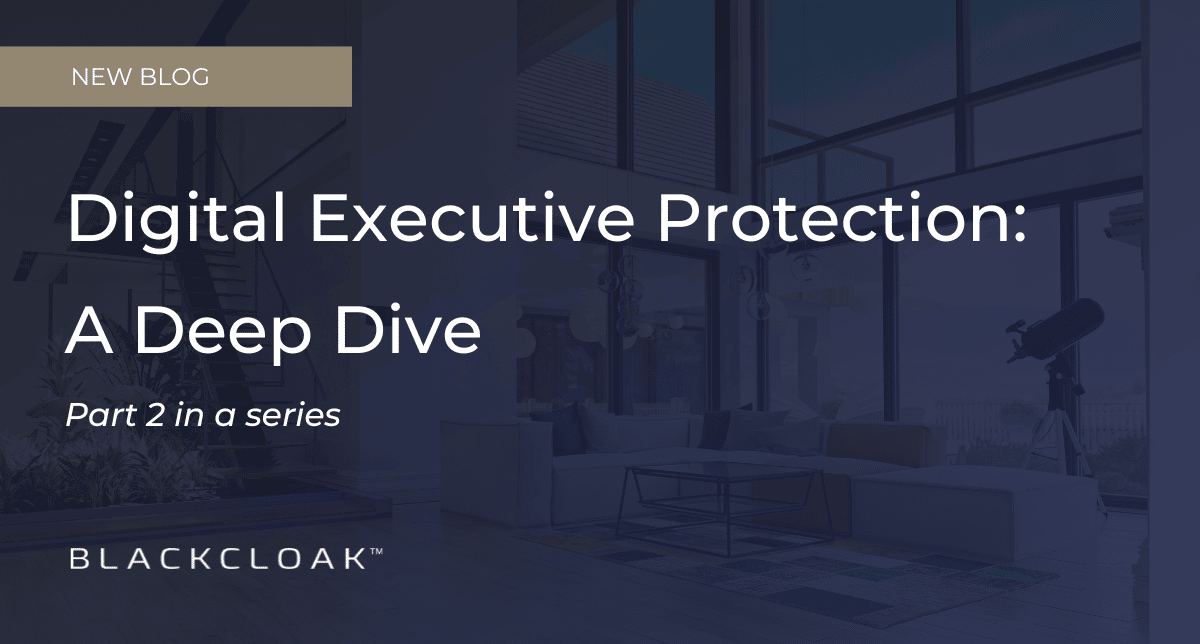Digital Executive Protection: A Deep Dive

In an earlier post, we explored “What is Digital Executive Protection?” In simple terms:
“Digital Executive Protection is the identification, protection, and remediation of cybersecurity and privacy risks that exist in the personal life of the executive and their family . . . it includes their private information, personal devices, homes, and key online accounts. And each of these items affords a chance for a hacker to then compromise the company.”
Why is digital executive protection needed?
We can offer up countless examples of where executives have been targeted by threat actors and nation states in their personal digital lives. Just look at the Twilio and Uber attacks, and political campaign attacks over the past decade. Cybercriminals aren’t going to stop at the corporate front door, they will follow and target executives and families wherever they are.
The importance of holistic digital executive protection
A holistic and active defense methodology is the only way to reduce the attack surface for corporate executives, board members, and executive leadership teams.
Just like concierge medicine, where you treat the whole body, so too with digital executive protection. CISOs must treat the executive and their family holistically. They must address every system: personal devices, online privacy, and home security and put protective mechanisms in place to ensure peace of mind.
But how? Let’s dive into the core elements of digital executive protection:
1. Privacy
CISOs must find ways to ensure that bad actors can’t target executives in their personal lives. To do this, they must ensure that:
- Executive phone numbers, IP address, account numbers, and family information are not available on the data broker websites.
- Executives and their families are not complacent with password security and they know the websites they use that have had breaches.
- Personal devices are hardened against hacks.
- An executive’s digital persona is masked or cloaked so that bad actors can’t find them.
Essentially, it comes down to reducing the executive’s attack surface to an acceptable level with no friction to the user. This is what privacy means to us and the CISO community that we serve.
2. Device protection
Executives’ personal devices need to be protected, not by the company (read this post for reasons why), but by a 24/7 enterprise-grade cybersecurity team that monitors, responds to, and protects each device against malware, intrusions, and even risky user behavior.
A team who can detect and respond to cyber threats – outside the purview of the corporate network – as well as any endpoint detection and response (EDR) that needs to be handled.
Deception technology is also key. Executives are constantly targeted by nation states, especially intellectual property seekers and privateers. Deception serves as a decoy or honeypot that deceives hackers by attracting them away from valuable data and diverting them into a trap.
While device protection is essential, it must not infringe on the privacy of executives or their families. Many executive protection solutions claim to protect personal devices, but they vacuum executives’ data and copy their emails – a gross violation of privacy.
3. The executive’s home
The home is a living, breathing environment. But it’s also the new battleground for digital executive protection. You can literally protect every device and every digital account – but if the front door is open a bad actor can literally digitally walk in. In addition to stealing devices and data, they can even attempt to hack the corporate network via an executive’s laptop.
But protecting the executive home network is complicated. The average home in the U.S. has 20.2 connected devices. Executives likely have much more. Yet many of these devices are insecure. Think high-end audio visual and smart home systems. Independent dealers often set up these systems in a way that leaves the home wide open to hackers.
What’s the fix? Weekly penetration testing can ensure a strong foundation of cybersecurity protection in executive homes. Read more about how BlackCloak helps protect executives’ homes.
4. Peace of mind
Peace of mind is nuanced.
For example, CISOs and their teams want high-level metrics on their executives’ personal cybersecurity postures. They need reporting on what type of risk reduction is taking place and assurances that their executives are protected 24/7 in their personal lives – outside the company’s four walls.
Furthermore, they want a partner who provides ongoing security awareness education and training so that their executives recognize threats and understand what is required to minimize cyber risks.
BlackCloak has it covered
These are all facets of digital executive protection. Layered together, operating in harmony they significantly reduce the risk facing executives – and their families – in their personal digital lives.
If you’re an executive or board member and are looking for true peace of mind, click here to speak with a BlackCloak representative about implementing a personal cybersecurity and digital privacy protection strategy that protects your life online.








